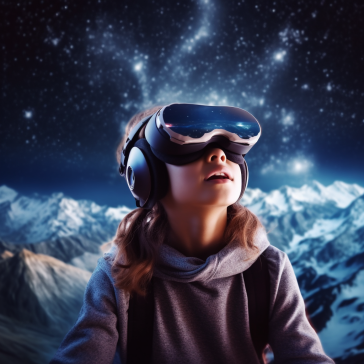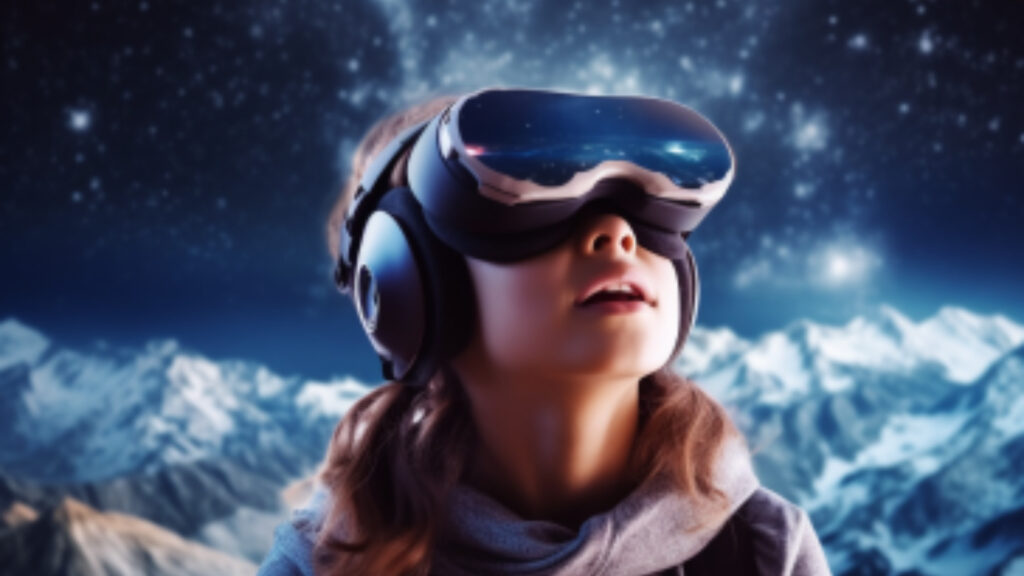

The advent of time travel has finally been realized – in VR of course! We can now traverse space and bend time with it. “The virtual reality environment allows students to fly through and around astronomical objects including stars and supernovae, and manipulate them to observe how they have changed over time" (Purdue University Newsroom). “ With its immersive capabilities and realistic simulations, VR has opened up new horizons for astronomy education. In this article, we will delve into the captivating world of immersive VR experiences for astronomy education, exploring the benefits, advancements, and potential future applications of this technology.
The integration of VR technology in astronomy education has created an unparalleled learning experience for students. By donning a VR headset, learners can transport themselves into a virtual cosmos where they can observe celestial bodies up close and explore the vastness of the universe. This immersive experience is made possible through the use of enormous quantities of rich 3D modeling information and analyses, ensuring scientific fidelity and providing a clear and accurate depiction of datasets.
VR provides a level of immersion that traditional classroom settings simply cannot replicate. Students can engage in interactive experiences, manipulating astronomical objects and observing their evolution over time. By exploring the virtual cosmos, learners gain a deep understanding of complex concepts, such as stellar life cycles, galaxy formation, and the impact of celestial events. The accuracy and scientific fidelity of the VR simulations enable students to comprehend and visualize astronomical phenomena with unprecedented clarity.
The potential of VR extends far beyond astronomy education. Drawing inspiration from the Purdue University professor's quote, similar VR systems could be developed to facilitate the study of various topics, including microscopic or cellular data, anatomy, geospatial terrains, historical locations, or even complex animated machinery. This versatility allows for interdisciplinary learning, encouraging students to explore different fields and fostering a holistic understanding of the world around them.
The rapid advancements in VR technology have significantly enhanced the educational potential of immersive experiences. High-resolution displays, improved tracking systems, and realistic haptic feedback have elevated the VR experience to new heights. Additionally, the integration of machine learning and AI algorithms enables real-time interactions, adaptive learning, and personalized educational experiences tailored to each student's needs. These advancements ensure that VR technology continues to evolve, creating increasingly realistic and impactful educational simulations.
VR technology offers several advantages to educators and institutions. It provides a cost-effective solution for accessing astronomical observatories and locations that are otherwise inaccessible. Moreover, VR overcomes the limitations of physical resources, allowing students to witness rare astronomical events and phenomena regardless of their location. Virtual classrooms promote collaboration, as students can engage in shared experiences and group projects, fostering a sense of community and enhancing the learning process.
The benefits of using VR in specific educational settings extend beyond astronomy education. McGovern and colleagues (2019) found that when assessing students' communication skills, the use of virtual reality outperformed traditional teaching methods. Similarly, in a meta-analysis conducted by Villena-Taranilla and colleagues (2022), a significant improvement in learning gains was observed when VR was utilized. However, the authors acknowledge the need for further research to determine the precise impact of virtual reality on education. More studies are necessary to explore its potential fully.
While the integration of VR in astronomy education brings immense benefits, there are also challenges and considerations that need to be addressed. One challenge is the initial cost of acquiring VR equipment and software, which can be a barrier for some educational institutions. However, as technology becomes more accessible and affordable, the cost of VR setups is gradually decreasing, making it more feasible for adoption.
Another consideration is the need for proper training and support for educators to effectively utilize VR in the classroom. Teachers need to familiarize themselves with the technology, understand its potential applications, and develop appropriate lesson plans that maximize the learning experience. Collaboration between educators, VR developers, and researchers can play a crucial role in designing effective VR-based astronomy curricula.
Ensuring equitable access to VR experiences is also essential. Not all students may have access to VR devices at home, so it's crucial for educational institutions to provide access to VR technology within their facilities. This way, students from all backgrounds can benefit from immersive astronomy education and bridge the digital divide.
Ethical considerations must be addressed as well, particularly when portraying sensitive or controversial astronomical topics in VR simulations. Educators and developers need to ensure that the content presented is accurate, unbiased, and age-appropriate. Maintaining scientific integrity and avoiding misconceptions are essential to promote responsible and ethical use of VR in astronomy education.
The potential for collaboration between educational institutions, VR developers, and professional astronomers is immense. Partnerships can lead to the creation of more comprehensive and accurate VR simulations based on real astronomical data. By working together, educators and scientists can ensure that VR experiences align with current discoveries and advancements in the field.
Furthermore, interdisciplinary collaborations can result in the development of VR simulations that bridge the gap between astronomy and other scientific disciplines. Imagine a VR experience that allows students to explore the microscopic world of celestial objects or dive into the depths of planetary geology. The possibilities for cross-disciplinary learning are limitless, offering students a holistic and interconnected understanding of the universe.
Immersive VR experiences in astronomy education have the potential to revolutionize the way we teach and learn about the cosmos. By providing students with interactive and realistic simulations, VR enhances understanding, engagement, and curiosity. As the technology continues to advance and become more accessible, VR will undoubtedly become a powerful tool for educators, enabling students to explore astronomical wonders and embark on scientific journeys that were once only imaginable. By embracing this transformative technology, we can inspire the next generation of astronomers, scientists, and explorers to reach for the stars and unravel the mysteries of our universe.
Created By Euphoria XR | Privacy Policy | VEDX Code of Conduct | Sitemap | Contact Us